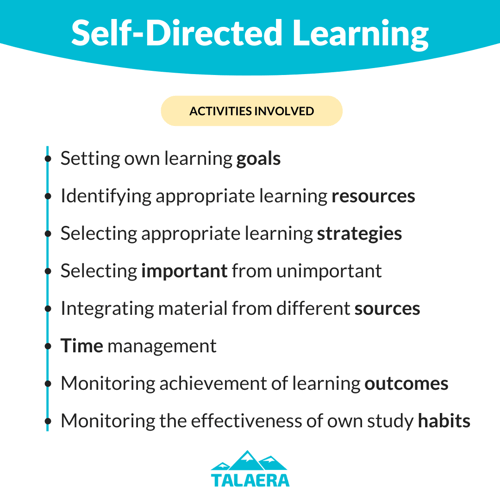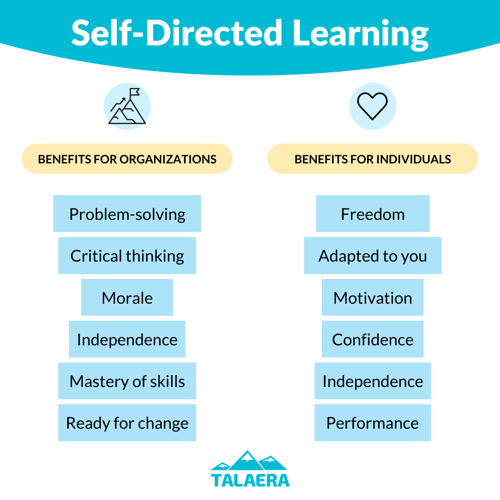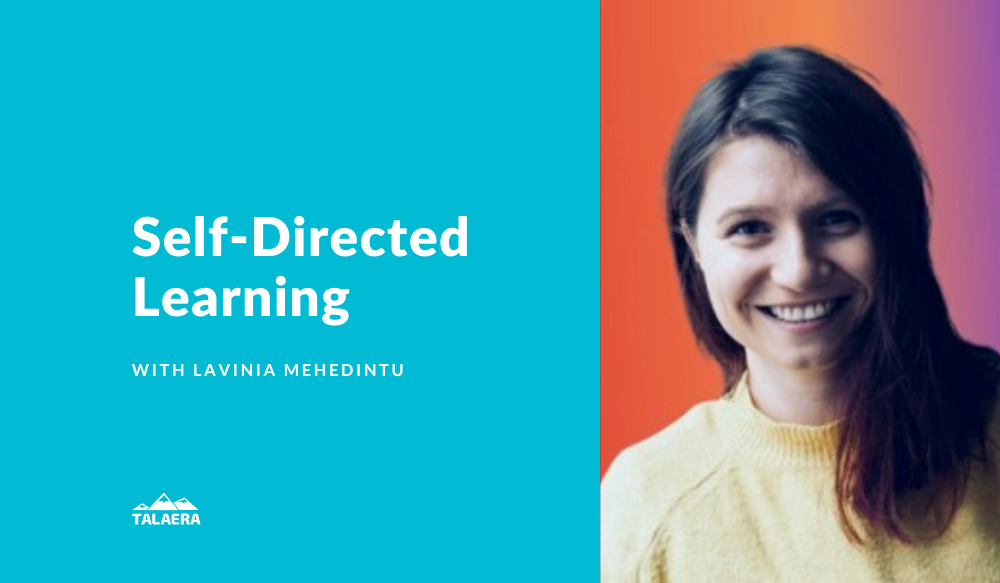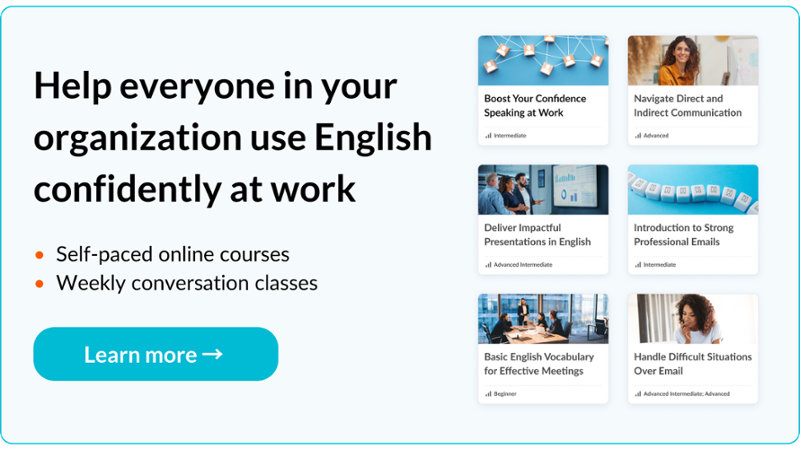By Talaera Talks on Nov 8, 2022 8:22:47 AM
Listen to this episode on Spotify, Apple Podcasts, Google Podcasts, or Buzzsprout.
There is no one theory or model of adult learning that explains everything we know about adult learners, the contexts where learning takes place, and the process of learning itself. What we do have is a mosaic of theories, models, sets of principles, and explanations that, combined, compose the knowledge base of adult learning (Merriam, 2002). And a significant piece of that mosaic is self-directed learning.
Self-directed learning (SDL) is a term that is often used in education and training circles, but what does it actually mean? In short, SDL is a form of learning that gives learners the responsibility and power to choose what they want to learn, when they want to learn it, and how they want to learn it. While this may sound like a recipe for disaster, SDL can actually be a very successful way of learning if it is implemented correctly.
In this new Talaera Talks episode, we talk with Lavinia Mehedintu, creator of L&D newsletter Offbeat, and explore what SDL is, how to implement it successfully across the organization, and how to foster learning autonomy.
What is self-directed learning?

Self-directed learning is a process where individuals take the initiative to identify their own learning goals, choose how they will achieve those goals, and then evaluate their progress (Knowles, 1975). This type of learning can be formal or informal, and it can happen inside or outside of a traditional educational setting.
SDL involves identifying human and material resources for learning, choosing and implementing appropriate learning strategies, and evaluating learning outcomes. It is about taking responsibility for, and control of, their own learning.
Self-directed learning can take different shapes and it can be implemented in a variety of ways, depending on the needs, goals, context, resources available, and preferences of the learner.
Some SDL programs are more linear, starting by diagnosing the needs, then identifying resources and instructional formats, and then evaluating outcomes. Others can be less linear and more interactive, factoring in the learner, the context of the learning process, the content, and the nature of the learning itself.
Self-directed learning activities

Benefits of self-directed learning

Self-directed learning can be an effective way to learn new skills and knowledge, as it allows learners to set their own goals, pace, and level of difficulty. Additionally, SDL can improve problem-solving and critical thinking skills, as well as motivation and confidence.
There are many benefits to implementing a successful SDL program. First and foremost, SDL can promote a deeper understanding of concepts and mastery of skills. When learners are in control of their own learning, they are more likely to engage with the material on a higher level, leading to improved comprehension.
Furthermore, SDL can also foster independence and self-sufficiency. Learners who are used to directing their own learning will be better equipped to take on new challenges without needing extensive guidance from others.
Finally, SDL programs can be more efficient than traditional instruction for certain people and in certain contexts, as they allow learners to progress at their own pace and focus on areas that they need the most help with.
Benefits of self-directed learning for organizations:
As a Learning and Development manager, there are proven benefits to helping your employees become more autonomous learners and implementing self-directed learning programs in your organizations.
- Improved problem-solving and critical-thinking skills
- Boost employee motivation and confidence
- Promote a deeper knowledge of concepts and mastery of skills.
- Foster independence and self-sufficiency
- Better prepared workforce to take on new challenges
Benefits of self-directed learning for learners:
If you like taking responsibility for what you learn, self-directed learning might be the right way to go.
- Learn what, when, and how you want
- Begin anytime - the timing is totally up to you
- Move and progress at your own pace
- Focus on your own interests
- Boost your confidence

Challenges of self-directed learning

Getting started.
There are a few challenges that come with self-directed learning. The first is that it can be difficult for learners to get started. It can be hard to know where to begin when there are so many possibilities. This is where having a plan comes in handy. Once you have a plan and some structure, it becomes much easier to get started with any self-study journey.
Discipline.
Another challenge is that self-directed learning requires a lot of discipline. It can be easy to get sidetracked or give up when things get tough. That's why it's important to set goals and stay motivated throughout the process.
Lack of time to reflect.
One important challenge of self-directed learning according to Lavinia is the lack of time to reflect and create space to practice. There is a big difference between learning something new and implementing it. Integrating new skills and concepts requires time, but with today’s fast-paced lives it becomes as difficult as the learning itself.
Keeping up.
Finally, one of the biggest challenges is simply staying on top of everything. Self-directed learning can involve a lot of different subjects and topics. It can be easy to fall behind or forget something if you're not keeping track of everything carefully. Again, this is where having a plan comes in handy.
Break down your goals and take things one step at a time. This way, you can make sure that you don't get overwhelmed and stay on track toward successful self-study.
Nudging learning autonomy
When we talk about nudging learning autonomy, we talk about ways to influence learners’ behaviors and attitudes without directly telling them what to do. Nudging is a term that was first coined by behavioral economists Richard Thaler and Cass Sunstein in their book Nudge: Improving Decisions About Health, Wealth, and Happiness. In the book, they define a nudge as "any aspect of the choice architecture that alters people's behavior in a predictable way without forbidding any options or significantly changing their economic incentives."
Nudging can also be used to influence learning behavior. For example, if you want students to become more autonomous learners, you could create an environment that encourages self-directed learning. This could include providing resources such as books, articles, and videos on a variety of topics, as well as giving students time to explore these resources on their own.
Nudging learning autonomy is about creating an environment where people are encouraged to become the owner of their learning journeys. In her Offbeat issue #101 about Driving Learning Autonomy 101, Lavinia poses the question “What factors influence learners’ autonomy?” That is, what nudges would we want to look at to help our employees own their learning?
The result of that reflection is a causal loop diagram, a network of factors that influence learner autonomy. Some of those factors have an impact on the organizational level, others on the individual level, and others on both.
One of the factors that influence learner autonomy is the quality of past learning experiences and accomplishments. At a more personal level, the level of discipline, motivation, curiosity, inspiration, and freedom of choice are also key components of this network. We will talk more about curiosity below.
Self-efficacy (an individual's belief in his or her capacity to carry out the behaviors needed to achieve a specific goal), self-worth, self-awareness, and mental and physical well-being also play an important role in self-directed learning.

Self-directed learners also need time to learn and to reflect on their learnings. They need clear learning goals and access to goal-applicable resources, and consistency in the learning process. Manager support and the quality of the feedback are also important.
At Talaera, one of our first goals is to help learners clearly define their learning goals. Once they have a clear vision, learners get access to high-quality resources that are carefully designed to achieve those specific goals. Our brand-new Talaera Self-Study aims to help working professionals develop their communications skills for work. Owning the process. At their own pace.
Curiosity in self-directed learning
“Why is it that when one man builds a wall, the next man immediately needs to know what's on the other side?” ― George R.R. Martin, A Game of Thrones

Curiosity, the key ingredient for a winning L&D strategy. That was one of Lavinia’s Offbeat #122 newsletter opening lines. This is true for any L&D strategy, but when it comes to Self-Directed Learning, curiosity takes on special significance.
SDL is based on the principle that learners are more likely to be successful if they are motivated and curious. Humans are built to explore, create, wonder, and learn. As curious creatures, we need curious environments that inspire us, and there is a lot that organizations can do. This means that SDL programs should be designed to encourage and support learner motivation and curiosity.
Intentional curiosity drives faster, deeper learning. And yet, most training providers forget about this important element.
While 83% of executives say their organizations encourage curiosity, only 52% of their employees agree. (HBR, 2018)
Stefaan van Hooydonk understood this misalignment and created a company that specializes in driving curiosity in organizations. Van Hooydonk, author of the bestselling book The Workplace Curiosity Manifesto, is a firm believer in the power of curiosity to benefit professionals, leaders, teams, and organizations.
How can L&D leverage curiosity?
While individual curiosity levels are key in self-directed learning, there are other enablers that organizations can work on to encourage their employees in their learning journey.
- Make curiosity a daily ritual.
- Cultivate psychological safety.
- Provide opportunities for employees to explore and discover new things.
- Encourage team members to ask questions and seek out answers.
- Support learner autonomy by giving them choices and allowing them to take control of their own learning.
- As a manager, help employees see the connections between what they are learning and their own lives and experiences.
- Make sure the resources you provide is interesting, engaging, and relevant.
- Cultivate a company culture where people ask and are grateful for feedback.
How to implement a successful SDL program

In Lavinia’s words, driving learners’ autonomy in a systematic way is hard. Everyone learns differently and we all have different goals and preferences. What works for one person may not work for another.
If you are looking to drive learner autonomy, providing the resources and then just assuming that people will direct themselves is a recipe for disaster (even if they're great resources). Providing the resources is a great step, but it goes beyond that.
She and her team at Offbeat are working on a research project to find out how L&D can nurture self-directed learning and she came up with three categories: attitudes, skills, and behaviors.
Attitudes.
The hardest category to influence is attitudes. Start by fostering curiosity, help your teams become more resilient, and encourage them to work on their discipline.
Skills.
Among the most relevant skills for SDL, learners need to know how to write clear learning goals, be aware of all the resources they have available, and have the ability to access them. Self-directed learners also need to be aware of all the different learning methods and, in the end, they need to know how to measure if they learned or not.
Behaviors.
When it comes to behaviors, learners need to actually put those skills and attitudes into practice. Reflection is crucial. Taking the time to reflect on what they need to learn, what they learned, and how they will apply it to their real lives is what will make SDL successful or not.
As L&D professionals, we cannot assume that employees will have the right skills, behaviors, and attitudes to become effective self-directed learners. Instead, we have a responsibility for the organization and for the individual to nurture learning autonomy.
Ask yourself:
- Self-reflection. Does my team have the time and space to reflect on their learnings?
- Resources. Do they have the tools to become more self-aware?
- Psychological safety. Do your employees feel psychologically safe?
- Management. Are managers pushing employees to become owners of their learning journey?
- Practice. Do employees have the space to practice?
- Consistency. Are we nurturing skills, behaviors, and attitudes that contradict self-directed learning (for example, by forcing employees to join specific learning programs and workshops)?
- Transparency. Do employees have a clear understanding of the company’s mission and vision? Do they have the visibility they need?
“Self-reflection is probably one of the most important yet hardest things to offer as an organization. Everyone is running. Nobody's sitting still for a minute to think about whatever they want to think about. So offering that time to self-reflect is very, very important.” -Lavinia

What can L&D do to foster self-directed learning?
When implemented correctly, SDL can help employees take greater ownership of their learning, develop important skills for today’s workplace, and boost their performance.
However, one thing we learned from Offbeat on how to nurture SLD is that each system is different. You need to understand YOUR system before thinking about any solution to drive learners’ autonomy.
Lavinia shares this helpful 3-step framework that L&D professionals can use to foster SDL in their organizations.
1. Communicate the mission
The first step is to communicate very, very specifically where you're heading and how you're going to get there. Provide clarity about your company’s mission, vision, purpose, strategy, and goals – and communicate it often. Don’t keep it to yourself. Then, involve your teams in setting their SDL goals so that they buy into the process.
2. Offer the right resources and space
The second thing is to offer both employees and leaders the resources and the space for people to learn. Understand their goals and how they align with your mission and provide the tools and resources for them to achieve them. Offer a variety of courses and learning opportunities. Understand that e-learning is not for everyone –the same way structured courses are not for everyone either, and that’s where a more diverse and strategic list of solutions comes into play! Additionally, it is important to create a supportive learning environment for learners where they feel comfortable taking risks and trying new things.
Help your teams communicate more effectively accross cultures with Talaera's free resources and upcoming webinars.
3. Nurture self-awareness
While SDL encourages students to be independent learners, they will still need guidance and support from you along the way. Once your employees know where your organization is heading, the is a clear mission and vision, and they have the right resources, now it’s time to bridge that gap. Part of SDL is reflecting on one’s own learning process and progress. Help your employees make time for regular reflection by incorporating it into daily or weekly routines such as journaling or surveys. Give them time to reflect and apply what they have learned. Think about how you, as a manager, can help your teams utilize those resources to their full potential. It’s relatively easy to give people inspiration, but impacting self-efficacy and focus is a long-term game.
How can you, as an individual, become a more effective self-directed learner?
“Ask around!”, recommends Lavinia. Ask questions about the mission and the vision of your organization and find out what specific skills will help you be better equipped to get there. Also, ask colleagues –from your own and from other departments– about what they are working on and what learning programs have worked for them.
Nurture your curiosity. Surround yourself with people who are driven and who want to learn.
Keep a learning journal. Take a deep breath and put on paper whatever comes to your mind. Don’t try to write structured blocks of text. Rather, jot down whatever comes to my mind and the insights will come to you. Trust the process.
Some other general tips on how to become an autonomous learner include setting goals, seeking feedback, and practicing self-reflection.
- Self-assess your readiness to learn
- Define your learning goals and develop a learning contract
- Re-evaluate and modify goals as required throughout your learning experience
- Monitor your learning process
- Take initiative for all stages of the learning process
- Find nudges that will keep you motivated and curious throughout your learning
- Consult with your advising instructor
About Lavinia Mehedintu
Lavinia Mehedințu is a learning designer and entrepreneur with extensive experience in People Ops, including employer branding, recruitment, onboarding, engagement, internal communications, and learning and development. Lavinia has used this deep knowledge of learning design to launch a newsletter for L&D professionals called Offbeat –a must for all L&D professionals. Offbeat’s mission is to become the first place that all L&Ds think of when they search for inspiration, answers learning and growth opportunities, learning partners, and new jobs as well. She also recently launched her podcast Offbeat On Air. In this Talaera Talks episode, Lavinia shared invaluable insights into self-directed learning and how L&D professionals can nurture it in their organizations.
Listen to the full episode
Listen to the episode on your favorite platform - Spotify, Apple Podcasts, Google Podcasts, Buzzsprout, and many others!
Effective Workplace Communication
At Talaera, we are firm believers in learning autonomy, and so, we created a learning ecosystem where working professionals can improve their communication skills that match their needs, goals, and learning preferences. Apart from teacher-led programs, your teams can now improve their communications skills with our business English self-study.
For any additional information or questions, you can also reach out at hello@talaera.com. Interested in getting the best offers and receiving free content on Business English communication? Subscribe to our newsletter and we will keep you in the loop with offers, free events, and development materials!
If you enjoyed this article, keep reading:
- How To Manage Language and Cultural Diversity in The Workplace [Guide]
- How to Break Down Silos and Boost Collaboration [Webinar]
- How Delegating Will Help You Grow And How To Do It Effectively
- 4 Reasons You Should Be Building Trust In Your Employee Engagement Game
- How To Overcome The Top 4 Communication Barriers In The Workplace
- 10 Qualities Of A Good Leader In Today’s High Tech Industry
- Working With Israelis? Use These 6 Excellent Communication Tips
- The 6 Communication Tips Everyone Working With Germans Should Know
- A Quick Guide To Asking Better Questions In Cross Cultural Workplaces
- 8 Tips On Direct Communication For Those Who Were Called "Too Direct"
- 13 Ways to Break Down Silos in the Workplace And Boost Collaboration
- 9 Tell-Tale Signs Your Employees Are Struggling With Cross-Cultural Communication
- How To Overcome The Top 4 Communication Barriers In The Workplace
- Cross-Cultural Communication


.png)


comments